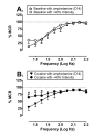The effect of chronic amphetamine treatment on cocaine-induced facilitation of intracranial self-stimulation in rats
- PMID: 24408209
- PMCID: PMC4040317
- DOI: 10.1007/s00213-013-3405-1
The effect of chronic amphetamine treatment on cocaine-induced facilitation of intracranial self-stimulation in rats
Abstract
Rationale: Chronic amphetamine treatment reduces cocaine self-administration in pre-clinical and clinical settings, and amphetamine has been proposed as a candidate medication for treatment of cocaine abuse.
Objective: The objective of the present study was to investigate whether chronic amphetamine treatment can decrease abuse-related cocaine effects in an assay of intracranial self-stimulation (ICSS).
Methods: Thirteen adult male Sprague-Dawley rats were equipped with intracranial electrodes targeting the medial forebrain bundle and trained to lever press for pulses of brain stimulation in a "frequency-rate" ICSS procedure. Cocaine (10 mg/kg) was administered before (day 0), during (days 7 and 14), and after (posttreatment days 1 and 3) 2 weeks of continuous treatment with either amphetamine (0.32 mg/kg/h, n = 7) or saline (n = 6) via osmotic pump.
Results: Prior to treatment, cocaine facilitated ICSS in all rats. Saline treatment had no effect on baseline ICSS or cocaine-induced facilitation of ICSS at any time. Conversely, amphetamine produced a sustained though submaximal facilitation of baseline ICSS, and cocaine produced little additional facilitation of ICSS during amphetamine treatment. Termination of amphetamine treatment produced a depression of baseline ICSS and recovery of cocaine-induced facilitation of ICSS.
Conclusions: These data suggest that chronic amphetamine treatment blunts expression of abuse-related cocaine effects on ICSS in rats.
Figures





References
-
- Anderson JL, Leith NJ, Barrett RJ. Tolerance to amphetamine's facilitation of self-stimulation responding: anatomical specificity. Brain Res. 1978;145(1):37–48. - PubMed
-
- Balster RL. Behavioral pharmacology: the current status. Liss; New York: 1985. Behavioral studies of tolerance and dependence; pp. 403–418.
-
- Bonano JS, Glennon RA, De Felice LJ, Banks ML, Negus SS. Abuse-related and abuse-limiting effects of methcathinone and the synthetic "bath salts" cathinone analogs ethylenedioxypyrovalerone (MDPV), methylone and mephedrone on intracranial self-stimulation in rats. Psychopharmacology (Berl) 2013 Epub ahead of print. - PMC - PubMed
Publication types
MeSH terms
Substances
Grants and funding
LinkOut - more resources
Full Text Sources
Other Literature Sources
Medical

